Attachment One
First joint recreational and commercial meeting to find solutions for Hawke Bay
finfisheries
15 July 2015
Overview
This was the first meeting facilitated by the Ministry of Primary Industries (MPI) involving both
representatives of the commercial and recreational sectors for the purpose of discussing local solutions to
finfisheries problems in Hawke Bay. The group would like to bring local iwi representatives to the table to
join discussions.
The terms of the meeting include:
• Conversations between parties must remain confidential.
• Comments for public release wil be discussed and agreed by the group before release.
• MPI will provide summary notes of the meeting.
• Some agreed on messages will be collated at the end of the meeting.
The remaining agenda of the meeting was broadly split into five sections:
1. Setting the scene – outline of the issues
2. Overview of Hawke Bay fisheries information
3. Solutions and initiatives
4. Outcomes
5. Next steps.
Setting the Scene – outline of the issues
The recreational representatives were asked to give an outline of the Hawke Bay recreational issues as
they see them. These included:
• Recreational fishers are not experiencing success in grounds where they have historically fished.
This is not a new issue and has been happening for about 10 years.
• Fishing clubs have noticed a decline in catch of key finfish species. The decline has been
dramatic and severe over a number of species and is getting worse.
• Recreational fishers want the trend reversed.
• Representatives are interested in resolving finfish problems, but not for species like crayfish
where recreational landings are currently healthy, which they consider may be related to the
establishment of the Moremore Mataitai in Hawke Bay.
• Kahawai is an important species for surfcasters and there are concerns that catches are
declining off the beach for this species in Hawke Bay.
• Shore fishing is much worse than fishing from a vessel.
• Membership for local fishing clubs is either staying static or declining. It is believed this is due to
the poor recreational fishing in the Bay.
under the Official Information Act 1982
• “Hawke Bay” is the primary area of concern that needs to be addressed, but similar declines
have also been seen outside.
Overview of Hawke Bay fisheries information
MPI presented a brief overview of the Hawke Bay fishery, including reported commercial catch for key
species within the 0-50m and 50-100m depth contour lines for the last five complete fishing years.
Points raised by both sectors in discussions included:
• Commercial catch within the 0-50m contour appears to have declined over the past 5 years for
gurnard and snapper and that they consider this reflects what they are seeing in their club ramp
Released
survey results.
2
• There are not major concerns with the flatfish fleet in the Bay (i.e. the day boats). They are
interested in the bycatch (i.e. of gurnard) of this fleet, but do not necessarily want to stop the day
boats fishing in the Bay.
• Boat based recreational fishers are predominately interested in the health of gurnard, snapper,
hapuku/bass, trevally and tarakihi fisheries.
• An updated chart was requested from MPI containing all fisheries restrictions and closures.
• Questions asked regarding the potential for protecting spawning areas. It was suggested that
this was a potential initiative on the table for discussion.
• The results from recreational ramp surveys and surfcasting results were presented by the
recreational representatives for the 2006-2015 years. It was presented to show there have been
dramatic decline in the average catches of snapper, gurnard and groper.
• Commercial indicated that gurnard had been caught in the 70m depth contour this fishing year,
which was deeper than previous years. The reasons for this are unknown, however.
Both parties to consider the spatial area of focus and what areas were most visited by commercial
and/or recreational fishers. With a wider scope it can be more difficult to address and find potential
solutions.
Solutions and initiatives
MPI considers that the first priority for Hawke Bay is to find local solutions to the problems facing the
finfisheries in Hawke Bay. This is while recognising that there may be broader issues at play that may
be influencing a local limited availability and/or decline in some finfish species. Working together may
provide better opportunities to influence and get changes in the environmental monitoring and research
space.
Description and explanation was provided by the recreational representative for the
New Zealand Sport
Fishing Council GUR 2 Policy available at
http://www.nzsportfishing.co.nz/index.cfm/pageid/389/ViewPage/Gurnard-2-Policy. Specific points
include the need to protect shallow waters and the impacts on recreational fishers from localised
depletion. Questioned what sort of economic analysis had been considered during policy development on
the impact to commercial. Answered that no specific economic impact analysis had been undertaken.
It was noted that at the quota management area level, available information did not suggest there was a
sustainability concern for the GUR 2 stock. Commercial catches have typical y being under the Total
Allowable Commercial Catch, but this does not necessarily suggest a sustainability concern. Therefore,
at this point in time, there is no strong rationale to vary the Total Allowable Catch. Considers that the
best approach is to look at new ways to monitor performance of the fishery. If this information shows
that there is a sustainability concern measures will be explored at the quota management area level.
Gear Technology under the Official Information Act 1982
It was explained that some industry initiatives are undertaking to modify trawl gear to reduce waste,
capture of juvenile fish and fish that are hard to market. Multiple configurations are being trialled by
different operators, including the use of escape panels, increased mesh size and T90. The
configurations used do not necessarily suit all situations and there may be better configurations that
could be found. It was noted that there are other industry benefits from gear modifications than just to
release juvenile fish, which can include market and economic reasons.
It was raised that there could be benefits in ensuring that the development of all trawl net innovations are
coordinated towards an agreed upon standard/target and an encompassing research project should be
explored. It was suggested that MPI should lead the project if a broader research project was designed.
Released
3
Hawke Bay Aquatic Environment
The degradation of the aquatic environment of Hawke Bay was raised. MPI has commenced discussions
with the Hawkes Bay Regional Council who are very keen to meet with all interested parties in due course
to discuss the environmental monitoring work they carry out in the Bay.
MPI is open to facilitating
discussion with other agencies and stakeholders. An option could be to create a dedicated multi-sector
group to continue discussing concerns for the Bay.
Information and Monitoring
The need for better measures of abundance was discussed for key finfish species in Area 2.
Research trawl survey (a scientific survey where fishing is undertaken to obtain information) was not
considered cost-effective in Area 2. A more cost effective measure could be for industry vessels to
undertake a trawl survey themselves with an agreed to methodology. The potential for better information
from analysis of commercial catch reporting was also discussed given the changes that had been made
to reporting forms to help obtain fine scale data from trawl vessels (from 2007).
Not all members were convinced that revisiting the same research approaches was going to help the
situation and were interested in new ideas for monitoring the abundance of fishstocks.
Spatial and/or temporal separation
Information suggests there could a competition issue for gurnard between recreational and commercial
fishers within the 50m depth contour, particularly to the southern end of the Bay. 60-70% of surfcasters
are on the Northern shore of the Bay and that they have experienced declines in catches.
Clarification was requested on what areas are in discussion for changes to fishing restrictions. Hawke Bay
was the primary area of concern for recreational fishers.
under the Official Information Act 1982
Released
4
Meeting between Commercial and Recreational stakeholders to discuss Hawkes Bay
Finfish Fisheries
Meeting overview and Action Points
Meeting Date:
6 October 2015
Initial industry proposals
Presented a proposal for management of finfish fisheries in the Hawke Bay based on the following five key
principles:
• The situation in the Hawkes Bay is a local issue with wider implications.
• Hawke Bay is a shared fishery and all fishers should be involved. Mandated customary
representatives should be included in discussion.
• Each sector must play its part.
• Management should be based on sound science and monitoring. All sectors should use data
col ection protocols subject to MPI Science Working Groups.
• There is a need for greater understanding around all pressures affecting the productivity of
fisheries.
The proposal described the creation of an Area 2 Code of Best Practice, including adoption of electronic
monitoring and gear modification, as wel as voluntary spatial measures for the Freshwater springs area.
Commercial representatives stated that the proposal had stemmed from multiple engagement with its
members and had wide input. It was noted that customary input is important and has been raised earlier in
the process by industry representatives.
Code of Best Practice proposal (electronic monitoring, VMS, gear trials)
• Electronic reporting of catch and effort to improve accountability, science data and better vessel
management. Starting immediately in HB area and implemented progressively across Area 2.
• Vessel Monitoring Systems that track vessels movements in real time.
• Gear trials to be extended to improve survivability of small fish and reduce waste.
Comments:
Explained that the VMS systems that have been developed can be expanded to include camera systems.
There is potential for gear trials to be extended to improve survivability of small fish and reduce waste. This
could be further verified with cameras. It was noted that the code of practice measures would create
pressure on operators that were not up to standard.
Lachlan Banks initial proposal
• Industry initial y proposed that they were keen to learn more about recreational fishing on the
under the Official Information Act 1982
Lachlan Ridge and Banks. The area could be kept open to all sectors, but with reporting of all
catches
Comments:
Industry and recreational expressed concerns about the health of hapuku/bass (HPB) in the Lachlan area.
Based on catch data provided by MPI, the commercial catch in the area is reasonably low for finfish. It was
acknowledged that the Lachlans is a popular amateur charter vessel fishing spot. The recreational
representatives acknowledged that not many “mum & dad fishers” would travel out to the Lachlans.
Freshwater Springs initial proposal
Released
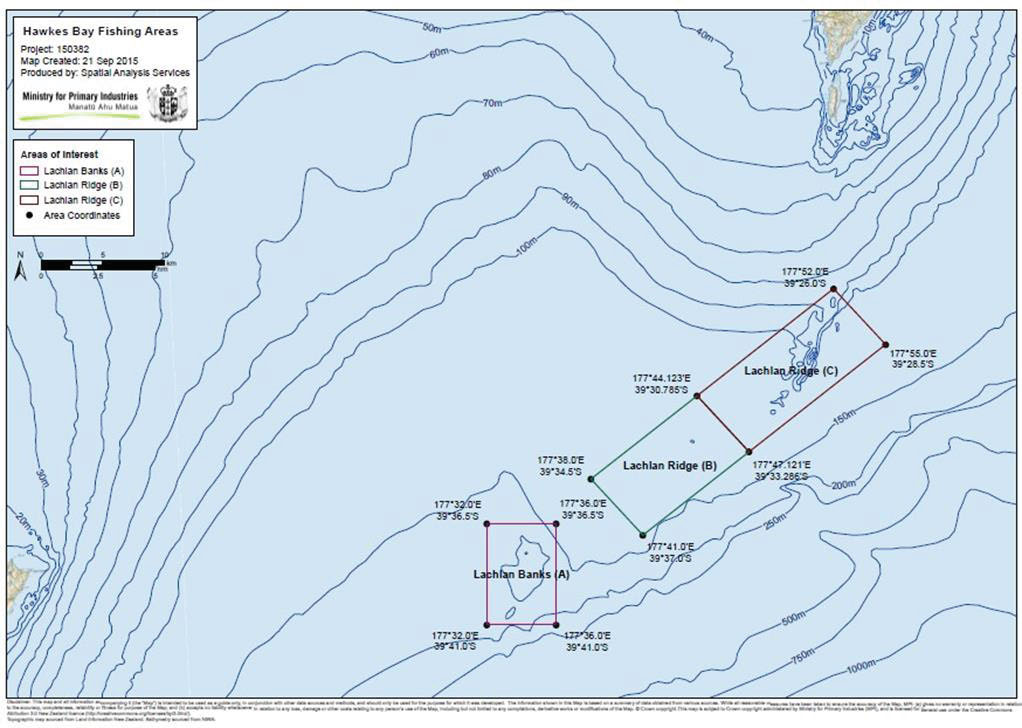
5
• Industry recognise that the freshwater springs area is an important recreational fishing area over
summer.
• To define the area as the “freshwater springs” area and not a spawn area. It is thought that the area
is where fish aggregate.
• It was noted that the area is 2.5 times bigger than Wellington Harbour.
• It is proposed that there will be a two year trial where the commercial sector will voluntarily stay out
of the area for 3 months of the year over the summer months.
• MPI to assist with ways for the recreational sector to report their catch.
• Voluntary measures will be monitored using VMS. Evaluation and review after two years
Commercial restrictions
• Industry noted that significant areas of Hawke Bay are already restricted to commercial fishing.
Any further restrictions without agreed evidence and planning could have a significant impact on
the local industry and other fisheries through fishing effort displacement.
Meeting outcomes
Discussed the details of the initial proposals presented by industry for consideration. The fol owing
outcomes and actions resulted from the discussions
Code of Best Practice
The electronic reporting, vessel monitoring systems, and gear trials proposed were supported. These
initiatives would provide information and fishery benefits over the medium-term. Other representatives were
interested in placing cameras on vessels. Placing MPI observers onboard was also discussed.
Lachlan Banks
under the Official Information Act 1982
Released
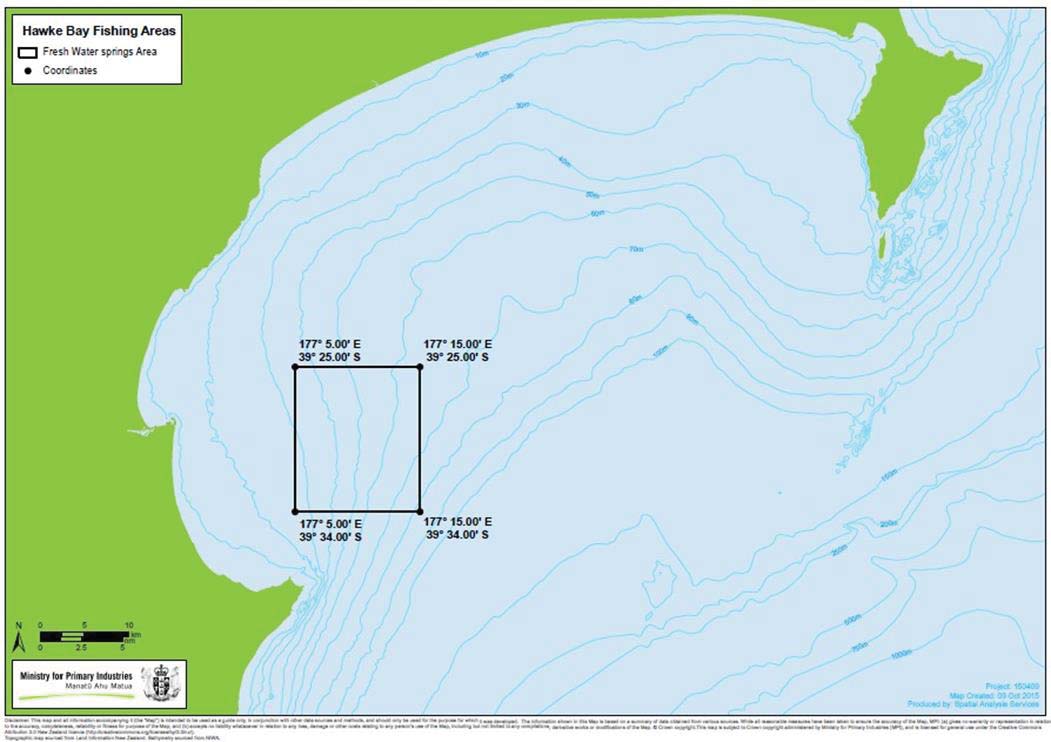
6
Initial proposal to leave the Lachlan area open to all fishing was discussed. Considered that some closure
of the area could be beneficial, especially for HPB. Given the biological characteristics of HPB in that they
are localised and don’t move very far from their residence, closing a small area to fishing could have
beneficial spillover effects. Agreed in principle, with voluntary measures
Freshwater Springs
Supportive of the voluntarily close the freshwater springs area to all methods for 3 months over summer on
a two year trial basis. It was noted that a methodology for evaluating the effectiveness of the voluntary
commercial closure needed to be considered and agreed ahead of time.
Commercial restrictions
under the Official Information Act 1982
Expressed concerns that the proposals tabled were unlikely to help surfcasters and asked if any other
measures were to be discussed, particularly within the 50 metre depth contour. It was acknowledged that
sedimentation and pollution may be playing apart in reducing availability of key recreational species close to
shore.
After discussion, spatial trawl gear restrictions were proposed for an area within Hawke Bay. The trawl
measures could help to reduce waste and juvenile mortality, and contribute to improving abundance.
Other supporting outcomes
Released
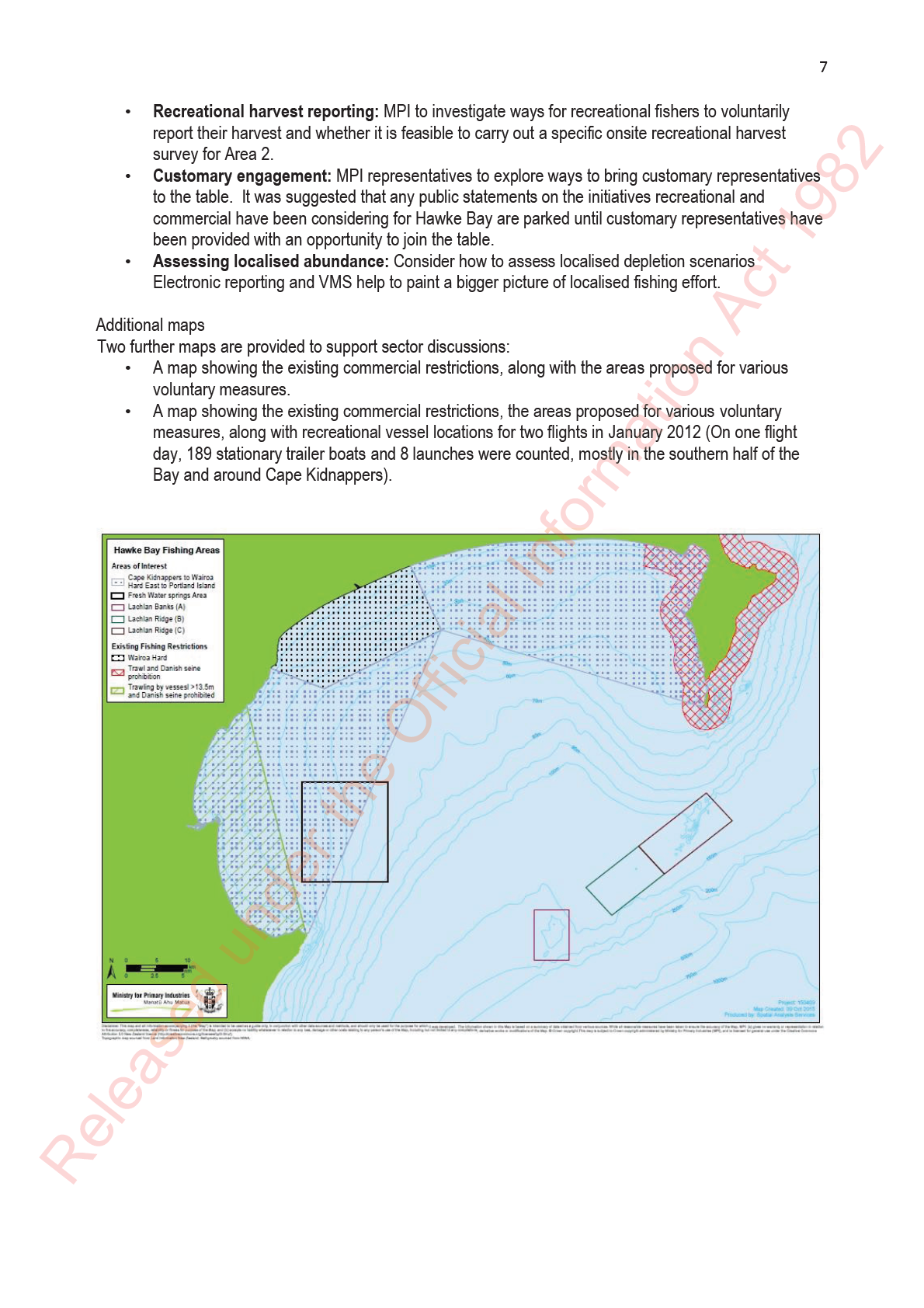
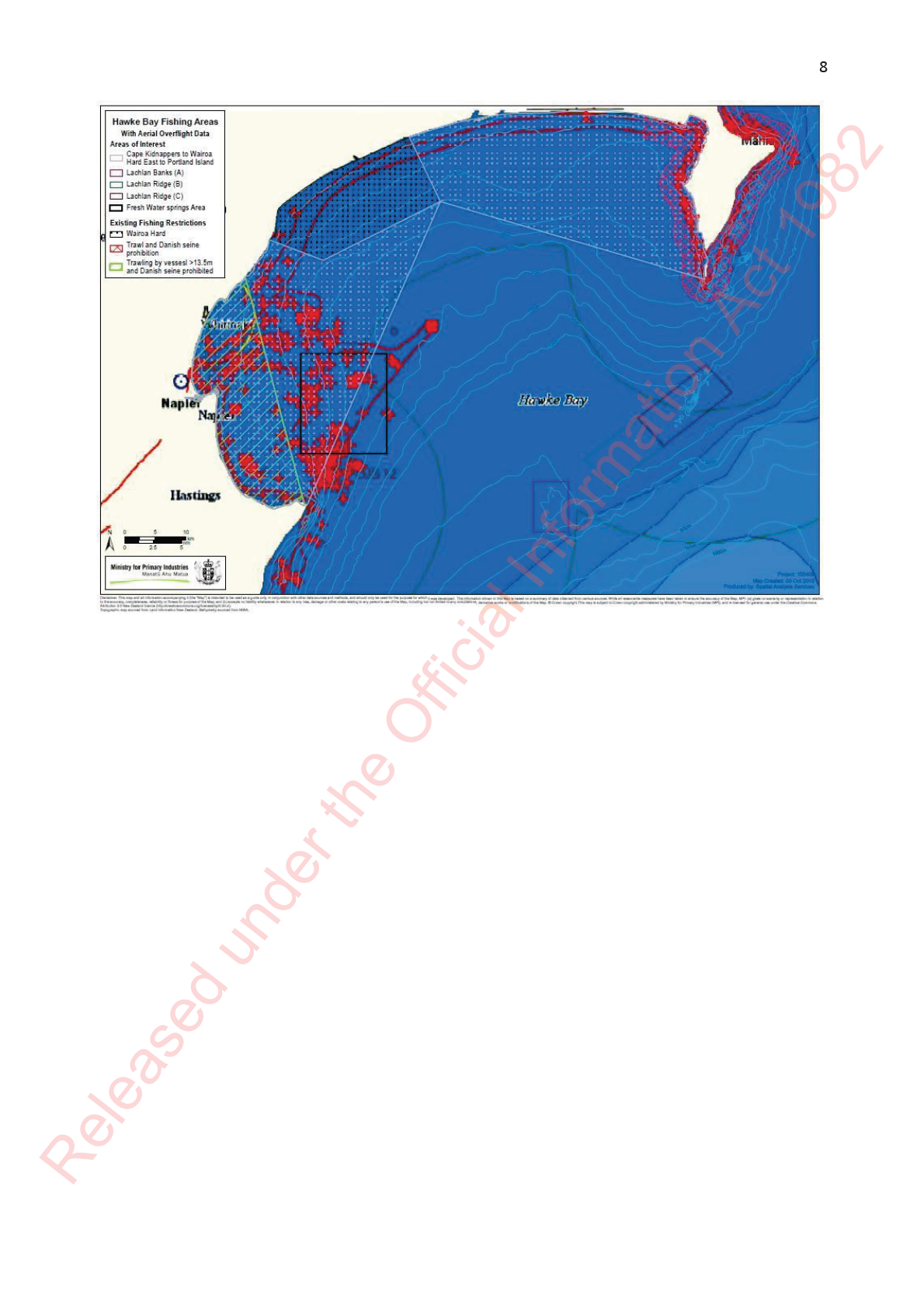
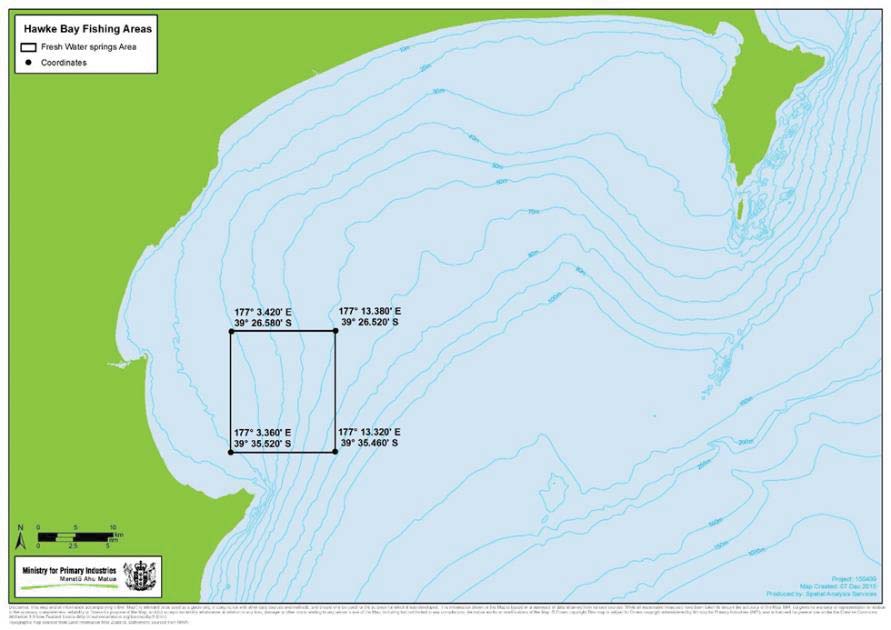
9
Meeting between Commercial and Recreational stakeholders to discuss Hawkes Bay
Finfish Fisheries – 4th meeting
17 November 2015
Initial industry proposals for management of finfish fisheries in Hawke Bay
Representatives of the commercial fishing industry presented a refined proposal for management of finfish
fisheries in Hawke Bay. This continued on from the proposals that were discussed at the last meeting on 6
October 2015.
In summary, the initial proposals presented by industry at the meeting included:
•
“Springs” Box. Voluntarily closed to all commercial fishing in December, January and February.
Industry proposed that the box could be moved slightly (west and south) to cover the main
recreational fishing area (as based on recreational vessel locations from two aerial overflights in
January 2012). Reporting and analysis of recreational catch (including charter take) from this area
is considered essential.
•
“Hawke Bay Abundance Zone” (the triangle from Cape Kidnappers to Wairoa Hard East to
Portland Island). Industry have agreed to the area covered and agreed to progressively use
modified/approved nets to reduce juvenile fish mortality and waste (100mm diamond mesh in
either/both the codend and lengthener will not be approved). It is also proposed that three special
permit net trials are carried out within the area (i.e. T90, cage system and the use of 125 mm
diamond mesh in the codend and/or lengthener) It is proposed that the targeting of flatfish will still
be allowed in the zone.
•
Lachlan Ridge and Banks. Better reporting from all sectors is needed for hapuku/bass, including
fine scale location, effort and individual species identification of hapuku and bass. It is proposed
that any measures for this area are based on better data/information. Industry are still interested in
progressing measures for this area but suggest these are worked through in April 2016 and are
based on data/information.
Meeting outcomes
Recreational, commercial and MPI representatives discussed the details of the initial proposals presented
by industry for consideration. The following outcomes and actions resulted from the discussions.
“Springs” Box
Agreed to move the “box” slightly to the area shown.
under the Official Information Act 1982
Released
10
Use of modified/approved nets in the Hawke Bay Abundance Zone.
Want the mortality of fish reduced in this zone so that abundance of key species can increase and the end
goal of increasing the recreational fishing experience is met. Acknowledge that net trials need to be done
within the zone to see if they are effective. Considerable discussion occurred on what nets and vessels
could be used in the zone. The following proposal was framed up by MPI and recreational for industry to
consider and discuss after the meeting with their representatives:
o Vessels that are on an approved net trial only can fish in the zone. No other vessels are
allowed in the zone in the short-term. The purpose of this approach is to immediately reduce
fishing effort and to ensure effective and proven nets are used in the zone that reduce mortality.
o The trial must involve a scientific and transparent process and method of determining what gear
is effective (including agreed timeframes).
o Three initial trials have been suggested: 1) T90, 2) cage system, and 3) selectivity trial using
125 mm diamond mesh in the codend and/or lengthener.
o During the trials the recreational fishing experience would be monitored to see if there is any
change in fishing success.
o Vessels with modified gear that meets an agreed criteria and is proven to reduce juvenile fish
mortality (i.e. of gurnard in particular) through the trials can then be considered for access to
the zone.
Preference to continue to allow some fishing in the zone and to improve the gear selectivity of the vessels
fishing there. If fishing selectivity is improved by vessels in the zone it is hoped that the fish available to
recreational improves. There is uncertainty in the time period that recreational fishers may see an
improvement in their catches from the improved selectivity There was no intention to prevent the “small day
boats” from fishing within the zone and to prevent the targeting of flatfish. The definition of a “small day
boat” needs to be worked through by industry and MPI.
Further details of the net trials need to be worked up It was noted that the trials needed to be meaningful
and be monitored so that the data col ected from the trials can be verified.
Lachlan Ridge and Banks Consider that hapuku and bass are in trouble in the Lachlan area. Prefer not to wait for more information
before taking action and consider that there is nothing to lose from shutting a small area even though
information on current abundance is uncertain. Warehou is caught at times by commercial set net on the
Lachlan Ridge when the fish are schooling. Need to discuss with the individual fisher involved and see if a
voluntary agreement can be made to not fish the area. MPI to undertake further analysis of the seasonal
warehou catches and provide to industry.
under the Official Information Act 1982
Released
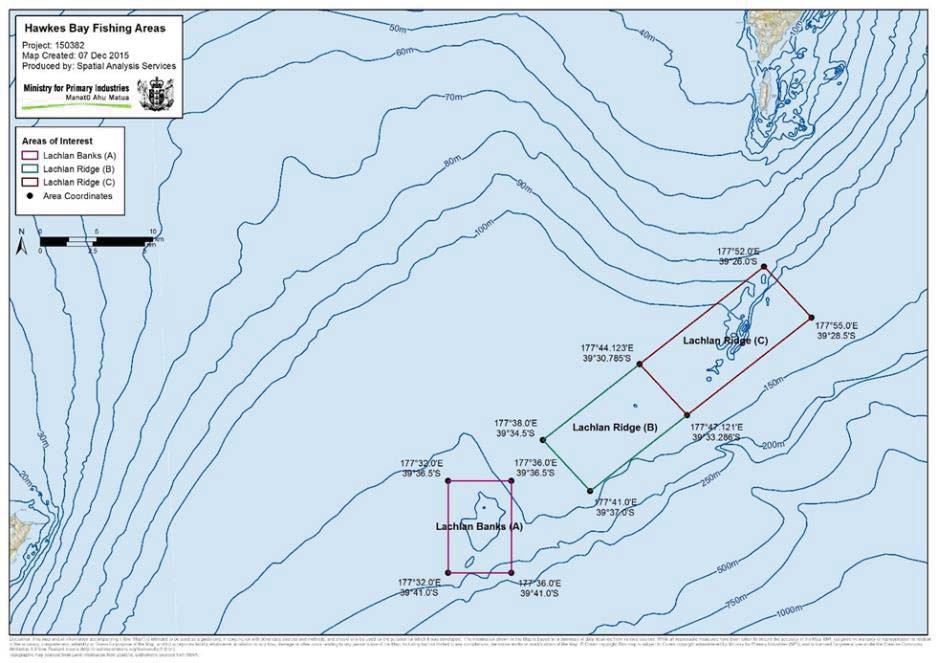
11
The voluntary measures that were discussed at the last meeting were revisited as potential proposals to
progress for the Lachlan area.
Measuring the recreation fishing experience
Propose to gauge recreational fishing success through established mechanisms. It is possible that
recreational fishers could be asked if they fished in the Springs box or Lachlan area and what their catches
are like.
under the Official Information Act 1982
Released
12
Hawkes Bay finfish Commercial and Recreational meeting
18 March 2016
1.
Hawke’s Bay Marine Information Strategy
Presented an outline of a project that has recently being commissioned. HBRC has contracted to complete
a Hawkes Bay Marine Information Strategy. The overall aim of the project is “Understanding the current
state of the Hawke’s Bay marine system and its response to pressures resulting from land-based activities”.
The key stages of the project include:
• Information gathering from tangata whenua and stakeholders, including HBRC, commercial and
recreational fishers, MPI, DoC and the National Aquarium;
• Developing a GIS database to summarise current marine information;
• Describing key marine habitats within Hawke’s Bay, including pressures on these habitats and key
species of interest within habitats;
• Identifying and prioritising where further research or investigation is needed to fill gaps;
• Development of a research strategy.
Key comments made through-out the presentation included:
• Sustainable management of the natural and physical resources (habitats) of Hawke’s Bay’s coastal
marine environment. The Coastal Marine Area of the region extends from Porangahau to north of
Mahia and out to 12 nautical miles. This is the spatial area of the project.
• Managing fisheries and fisheries resources within the coastal marine environment (and further afield).
• Management role in the coastal marine environment, including Marine Reserves, and marine mammal
and other wildlife protection.
• The GIS database part of the project wil breakdown the Coastal Marine Area into a series of grids:
Ahuriri Estuary 5m2 grids (HBRC has good information for this area), out to 50 metres – 100m2 grids,
and further out - 200m2 grids. Within each g id, links to all identified information sources wil be
available for interrogation and gap analysis
• Although not specifically decided on, the natural cut-off date for information sources is likely to be
around the 1950s.
• Preliminary findings so far include changes overtime in benthic communities, where people fish, water
clarity and water conditions.
• Col aboration between all interested parties is important, especially when trying to fill in the gaps.
• The strategy is intended to act as a bit of carrot to encourage researchers and universities to do more
work in the Hawke’s Bay marine space.
• There is a need to consider how management gaps will be identified, progressed in a timely manner
and what level of information is needed before taking action. Should management considerations be
incorporated in the current project, or come as an additional consideration afterwards as a separate
task? There are thoughts that the research gaps need to be identified first.
• It was suggested that a multi-sector sub-working group is established to discuss and progress research
under the Official Information Act 1982
and management objectives. HBRC will continue to provide regular updates to the larger group of
commercial and recreational representatives.
2.
Recap of agreed voluntary initiatives
A number of voluntary arrangements for commercial fishing in Hawke Bay at the Lachlans, the freshwater
springs and within Hawkes Bay Inshore Zone A. There were teething issues with the freshwater springs
initiative and that it took time to confirm the exact coordinates of the box and to get communications out to
all fishers. As a result, it understood there has been some fishing in the box. However, there appears to be
a shift in the mind-set within the fleet and there is a greater willingness to give effect to the initiatives.
Commercial catch information for February is currently being processed, because fishers were required to
Released
report their February catches by 15 March. MPI will be undertaking an analysis of commercial catch
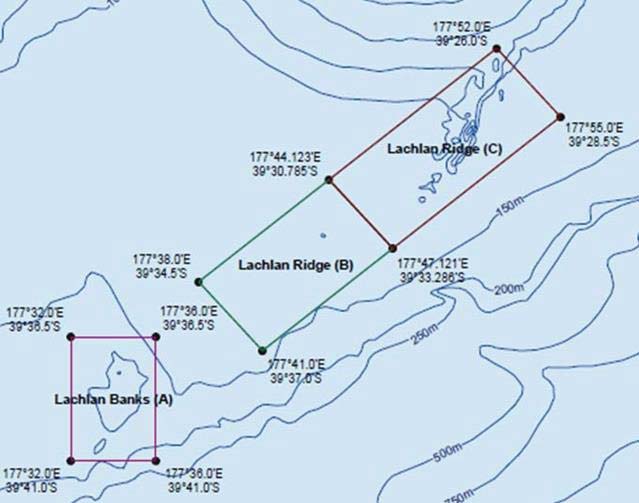

13
information for each of the voluntary initiatives in the coming month. Fishers are only required to give start
positions, therefore it is difficult to know where the fish were actually harvested from. Work has begun with
quota holders and fishers on fine-scale catch reporting.
A process issue was identified and that it is important that meeting actions are clearly documented so
everyone is clear about what is going to happen and when. It was acknowledged that another meetin was
ideally needed between recreational and commercial before any of the industry initiatives were
communicated to fishers.
a) Voluntary commercial and recreational initiatives for the Lachlans
b) Voluntary commercial initiatives for the Freshwater springs
under the Official Information Act 1982
Confirmed initiatives (new coordinates)
Released
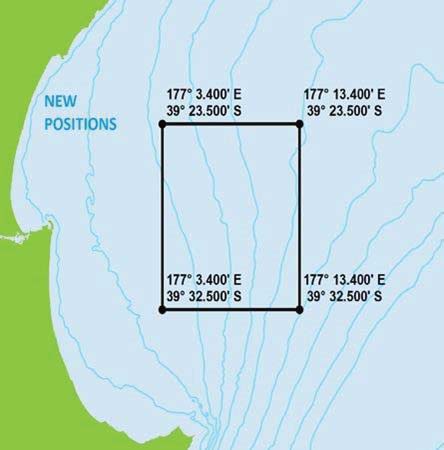
14
Outcomes from this meeting:
• Recreational do not consider that “Boaties” gained much from the springs box this season for
snapper. The box was officially in place for about 6 weeks given the teething problems.
• Ancedotal reports suggest some of the tensions between commercial and recreational fishers has
dissipated somewhat because trawlers were not in the box during the popular recreational fishing
period.
• MPI noted that the springs box was originally proposed by recreational representatives to protect
snapper during the spawning period.
• The box is part of an ongoing development package that hasn’t had a chance to fully operate and
determine if it is effective.
c) Recreational Proposal
Wish to revert back to their position on the 50 metre depth contour line within Hawke Bay, where there is no
commercial fishing at any time. Comfortable with the “small day boats” operating in the area, including
those who target flatfish; however, now have concerns with the flatfish bycatch.
Club ramp data shows declines in fish per angler per day for most key species. It was acknowledged that
there has been good snapper caught by surfcasters, but minimal gurnard have been caught off the beach.
There needs to be less fish kil ed in the Bay to enable abundance of key species (mainly gurnard) to recover
and reverse the declining trend experienced by recreational fishers. Something needs to be done to make a
meaningful difference for recreational fishers now.
Response:
under the Official Information Act 1982
MPI explained that it had no information to suggest there was a sustainability concern for gurnard or other
key finfish species for the wider management area (FMA 2). Hawke Bay is an issue of localised depletion,
not a stock sustainability issue. One of the aims of the voluntary initiatives has been to breakup competition
between sectors during the peak recreational fishing period. The tools available to address localised
depletion matters are limited and this is why exploration of voluntary measures is very important.
MPI considers that the current industry initiatives on the table, along with a robust monitoring programme,
may go some way to addressing the concerns expressed by recreational fishers. For instance, observer
coverage of the fleet makes it clear that fishers need to be operating within the rules, of which can result in
improved behaviour. This is the first time in a long time that initiatives have been put on the table and there
Released
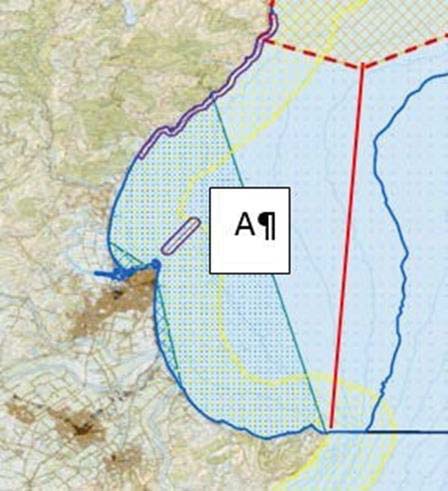
15
is a need to give them time to take effective and see if they are effective. If this assumption is wrong, then
we will need to explore further tools.
If industry withdrew from the 50 metre depth contour this would have a significant economic impact. Small
boats are unable to operate outside the 50 metre contour in winter due to safety concerns, therefore
people’s livelihoods are on the line with this proposal.
Recreational want the lack of gurnard within the 50 metre contour dealt with and there is a need to be
aggressive as possible to rebuild this area. The trawl net trials are admirable, but there needs to be more
done.
MPI suggested that people need to keep in mind the discussions and negotiations that have occurred to
date, and the progression and small steps that have been made.
d) Voluntary commercial initiatives for the Hawkes Bay Inshore Zone A
Nov 2015 Joint meetings
Initiatives were put forward:
suggested initiatives
1. Vessels on an “approved” net trial only can fish in zone A. No other
vessels are allowed in the zone at any time in the short-term.
2. Vessels with trawl gear that has meet an agreed criteria through trials
will be considered for access to Zone A.
Dec 2015 Confirmed
Initiatives confirmed for Zone A:
initiatives
1.Voluntarily move the 13.5 line from Waipatiki to the southern end of the
under the Official Information Act 1982
Wairoa Hard (Zone A), unless targeting flatfish or red cod.
2. All vessels within Zone A to progressively move to “approved” gear
designed to reduce juvenile catch and waste.
Zone B (northern Wairoa Hard to Portland Island) no agreements have
been made. Vessels operating in this area are encouraged to
progressively use trawl gear that is designed to reduce juvenile cate and
waste.
Jan 2016 Confirmed
Put forward the following initiatives:
initiative
The area bounded by Line C can only be trawled if the vessel is:
Released
1. Less than 13.5m, or
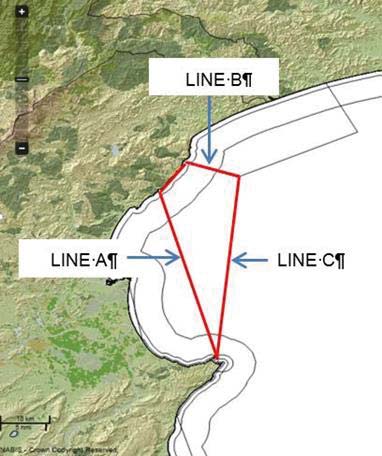
16
2. Part of a trial using an MPI special permit, or
3. Targeting flatfish or red cod and is taking steps to reduce juvenile
mortality, and
4. Using an approved electronic reporting device.
Feedback
x More is needed to rebuild gurnard abundance, in particular, and reduce
mortality.
x Concerns with the level of snapper and gurnard bycatch in the flatfish
fishery. Also, if fishers record that they are targeting red cod, gurnard
and snapper are still likely to be caught.
x What is an “approved” net trial needs to be defined.
x A metric for measuring the success of the initiative needs to be
determined
3. Development of a research and monitoring programme
a) Commercial trawl net trawls
Currently working on a methodology/best practice for catch comparison studies of two different fishing gears
– a control and experimental gear. A meeting is proposed to firm up the trial approach. The goal of the
trials is to come up with 2-3 trawl net configurations that should be used and are significantly better than the
status quo (noting the fleet has already moved away from 4 inch diamond mesh - the statutory minimum).
Within Hawke Bay it is intended that three different trials of trawl gear are undertaken to test the efficacy of
minimising juvenile mortality and waste, increasing yield-per-recruit, and building abundance of key species.
under the Official Information Act 1982
b)
Recreational harvest estimates
There is a need to monitor recreational harvest more to determine trends over time and whether the
recreationa fishing experience for key species is improving in association with the implementation of the
industry voluntary initiatives. A robust measure needs to be explored to monitor changes in recreational
fishing success.
In a broader sense, MPI has several recreational projects underway/proposed that relate to Hawke Bay.
These include (but are not limited to):
• MAF 2013-07: Developing new tools for monitoring recreational fisheries. Project nearly complete, with
the Fisheries Assessment Report to be made available to the Group shortly. This project looked at the
Released
HBSFC creel survey and Pania Surf Casting Club completion records.
17
• MAF 2015-06: Pilot testing of self-monitoring tools. Confirmed project to start soon.
• National Panel survey: currently being planned for and is a follow-on from the 2011-12 survey.
c)
Observer coverage
MPI is currently undertaking observer coverage planning for the 2016/17 financial year and have put forward
a number of days for Hawke Bay coverage. It is proposed that observer days wil be utilised for the trawl
net trials and in other areas where needed.
d)
MPI fisheries research
MPI provided a brief outline of planned 2016 fisheries research for FMA 2:
• TAR2016-01: East Coast tarakihi stock assessment (includes TAR 2)
• SCH2016-01: Characterisation and CPUE analysis of school shark in New Zealand (includes SCH 2)
• Industry direct purchase of FLA 2, GUR 2 and SNA 3 characterisation and CPUE analysis.
4. Media article
under the Official Information Act 1982
Released










